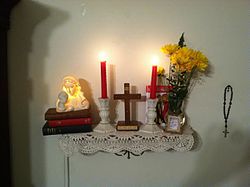Anglican prayer beads
Anglican prayer beads, also known as the Anglican rosary or Anglican chaplet, are a loop of strung Christian prayer beads used chiefly by Anglicans in the Anglican Communion, as well as by communicants in the Anglican Continuum. This Anglican devotion has spread to other Christian denominations, including Methodists and the Reformed.[1][2]
Description
[edit]Anglican prayer bead sets consist of a cross and thirty-three beads.
Beads
[edit]The loop is formed of 32 beads. 28 of the beads are divided into four groups consisting of seven beads, each which are called "weeks". The four larger beads separating the four groups are called "cruciform" beads. When the loop of an Anglican prayer bead set is opened into a circular shape, the "cruciform" beads form the points of a cross within the circle of the set, hence the term. Next after the cross on Anglican prayer bead sets is a single bead called the "invitatory" bead, which brings the total of beads to 33.
Materials
[edit]The beads used can be made of a variety of materials, such as precious stones, wood, coloured glass, or even dried and painted seeds.
Symbolism
[edit]The number 33 signifies the number of years that Jesus Christ lived on the Earth, while the number seven signifies wholeness or completion in the faith, the days of creation, and the seasons of the Church year.[3]
Cross
[edit]Anglican prayer bead sets are made with a variety of crosses or, occasionally, crucifixes. Christian crosses such as the Celtic cross and the San Damiano cross are two which are often used, though other styles are used as well.
Prayer
[edit]
Anglican prayer beads are most often used as a tactile aid to prayer and as a counting device.
The standard Anglican set starts with the cross or crucifix, which may begin with praying the Trinitarian formula. This is followed by the invitatory bead; the prayer for this bead may be taken from a portion of the 1662 Book of Common Prayer's responsorial formula in the Morning and Evening Prayer services, in the form "O God make speed to save me [or 'us'], O Lord make haste to help me [or 'us']". The Glory Be may also be prayed on this bead.[4]
This is then followed by the first cruciform bead, and then, moving to the right, the first set of seven beads, reaching the next cruciform bead. The rosary is continued around in this manner, and use of the rosary may conclude by saying the Lord's prayer on the invitatory bead, or a final prayer on the cross or crucifix.
The entire rosary may be prayed three times, signifying the lifetime of Jesus and the Holy Trinity.[3]
See also
[edit]Notes
[edit]- ^ Vincent, Kristen E. (1 March 2017). Beads of Healing: Prayer, Trauma, and Spiritual Wholeness. Upper Room. pp. 11–12. ISBN 9780835816373.
- ^ Walsh, Fran (20 April 2016). "Prayer Beads for United Methodists". The United Methodist Church. Retrieved 11 March 2017.
At the United Methodist General Conference, every delegate and church leader received a set of prayer beads made especially for 2016 in Portland. The United Methodist artist who helped craft the design says Protestant prayer beads are an idea that is catching on.
- ^ a b "Anglican Prayer Beads". King of Peace Episcopal Church. Archived from the original on 2019-02-01. Retrieved 2007-10-18.
- ^ "Trisagion and Jesus Prayer". King of Peace Episcopal Church. Retrieved 2007-10-18.
Bibliography
[edit]- Duckworth, Penelope (2004). Mary: The Imagination of Her Heart. Cambridge, Massachusetts: Cowley Publications. ISBN 978-1-56101-260-2.
- Schultz, Thomas (2003). The Rosary for Episcopalians/Anglicans (2nd ed.). Oakland, California: Regent Press. ISBN 978-1-58790-055-6.
Further reading
[edit]- Crosby, Gilbert T. (2000). Praying the Rosary: An Introduction for Episcopalians. Cincinnati, Ohio: Forward Movement Publications. OCLC 48854131.
- Durrad, W. J. The Anglican Use of the Rosary. London: A. H. Stockwell. OCLC 36764926.
- Elliott, Kristin M.; Seibt, Betty Kay (2001). Holding Your Prayers in Your Hands: Praying the Anglican Rosary (10th ed.). Denton, Texas: Open Hands. OCLC 229217288.
- Price, Anthony (1991). Reconsidering the Rosary. Grove Spirituality Series. Vol. 36. Bramcote, England: Grove Books. ISBN 978-1-85174-170-0.
- Smith, Charles (1969). The Rosary. London: League of Anglican Loyalists. ISBN 978-0-900894-08-4.
- Society of St. John the Evangelist, ed. (1975). The Mysteries of the Rosary: A Short Treatise. London: Church Literature Association. OCLC 2031861.
- Stowell, Renata (2004). The Anglican Rosary for Children: Prayers for the Young at Heart. Kelowna, British Columbia. ISBN 978-0-9735332-1-7.
{{cite book}}: CS1 maint: location missing publisher (link) - Vincent, Kristen E. (2013). A Bead and a Prayer: A Beginner's Guide to Protestant Prayer Beads. Nashville, Tennessee: Upper Room Books. ISBN 978-0-8358-1217-7.
- Winston, Kimberly (2008). Bead One, Pray, Too: A Guide to Making and Using Prayer Beads. Harrisburg, Pennsylvania: Morehouse Publishing. ISBN 978-0-8192-2276-3.



